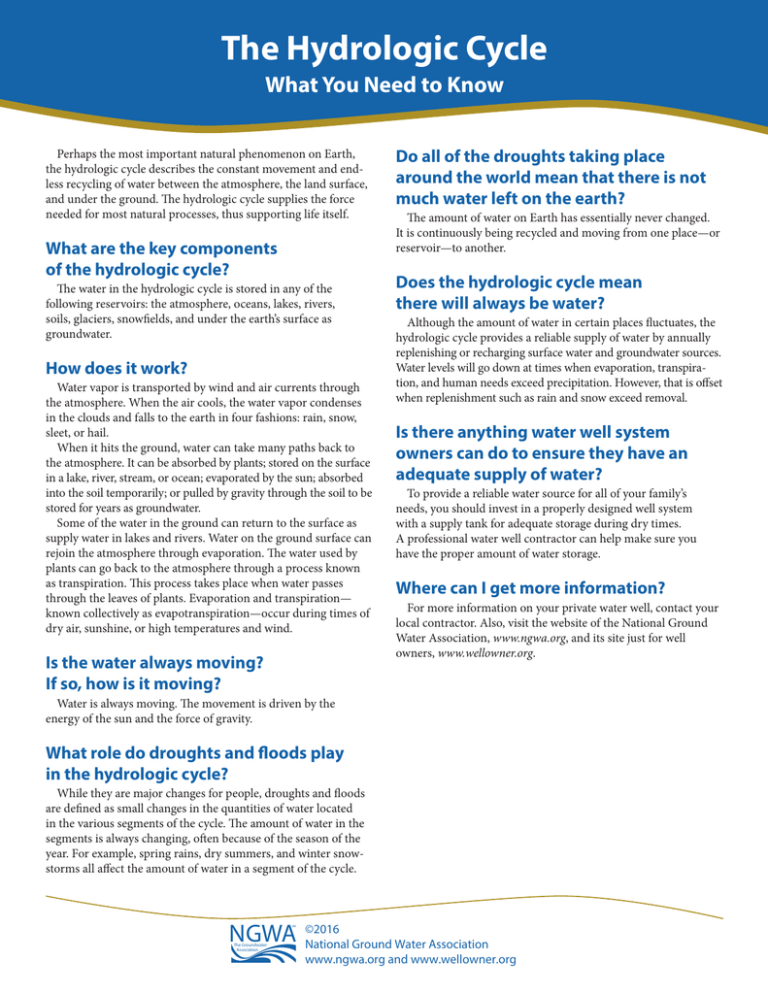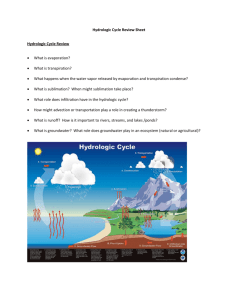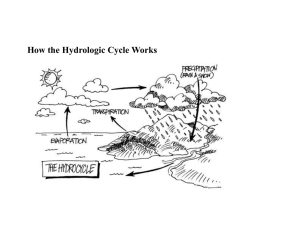The Hydrologic Cycle What You Need to Know
advertisement

The Hydrologic Cycle What You Need to Know Perhaps the most important natural phenomenon on Earth, the hydrologic cycle describes the constant movement and endless recycling of water between the atmosphere, the land surface, and under the ground. The hydrologic cycle supplies the force needed for most natural processes, thus supporting life itself. What are the key components of the hydrologic cycle? The water in the hydrologic cycle is stored in any of the following reservoirs: the atmosphere, oceans, lakes, rivers, soils, glaciers, snowfields, and under the earth’s surface as groundwater. How does it work? Water vapor is transported by wind and air currents through the atmosphere. When the air cools, the water vapor condenses in the clouds and falls to the earth in four fashions: rain, snow, sleet, or hail. When it hits the ground, water can take many paths back to the atmosphere. It can be absorbed by plants; stored on the surface in a lake, river, stream, or ocean; evaporated by the sun; absorbed into the soil temporarily; or pulled by gravity through the soil to be stored for years as groundwater. Some of the water in the ground can return to the surface as supply water in lakes and rivers. Water on the ground surface can rejoin the atmosphere through evaporation. The water used by plants can go back to the atmosphere through a process known as transpiration. This process takes place when water passes through the leaves of plants. Evaporation and transpiration— known collectively as evapotranspiration—occur during times of dry air, sunshine, or high temperatures and wind. Is the water always moving? If so, how is it moving? Do all of the droughts taking place around the world mean that there is not much water left on the earth? The amount of water on Earth has essentially never changed. It is continuously being recycled and moving from one place—or reservoir—to another. Does the hydrologic cycle mean there will always be water? Although the amount of water in certain places fluctuates, the hydrologic cycle provides a reliable supply of water by annually replenishing or recharging surface water and groundwater sources. Water levels will go down at times when evaporation, transpiration, and human needs exceed precipitation. However, that is offset when replenishment such as rain and snow exceed removal. Is there anything water well system owners can do to ensure they have an adequate supply of water? To provide a reliable water source for all of your family’s needs, you should invest in a properly designed well system with a supply tank for adequate storage during dry times. A professional water well contractor can help make sure you have the proper amount of water storage. Where can I get more information? For more information on your private water well, contact your local contractor. Also, visit the website of the National Ground Water Association, www.ngwa.org, and its site just for well owners, www.wellowner.org. Water is always moving. The movement is driven by the energy of the sun and the force of gravity. What role do droughts and floods play in the hydrologic cycle? While they are major changes for people, droughts and floods are defined as small changes in the quantities of water located in the various segments of the cycle. The amount of water in the segments is always changing, often because of the season of the year. For example, spring rains, dry summers, and winter snowstorms all affect the amount of water in a segment of the cycle. NGWA SM The Groundwater Association ©2016 National Ground Water Association www.ngwa.org and www.wellowner.org








